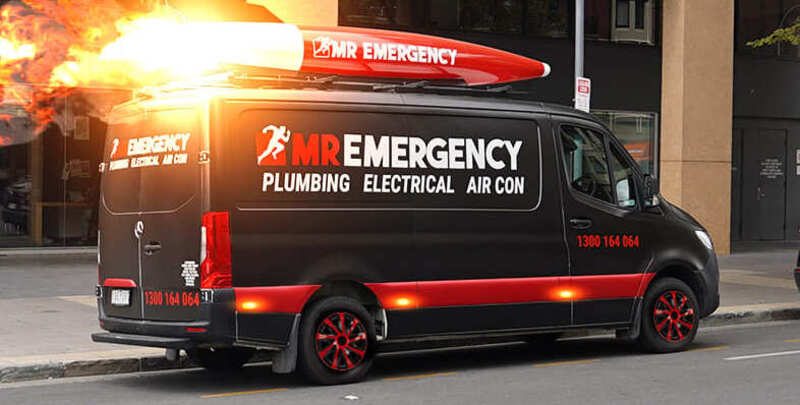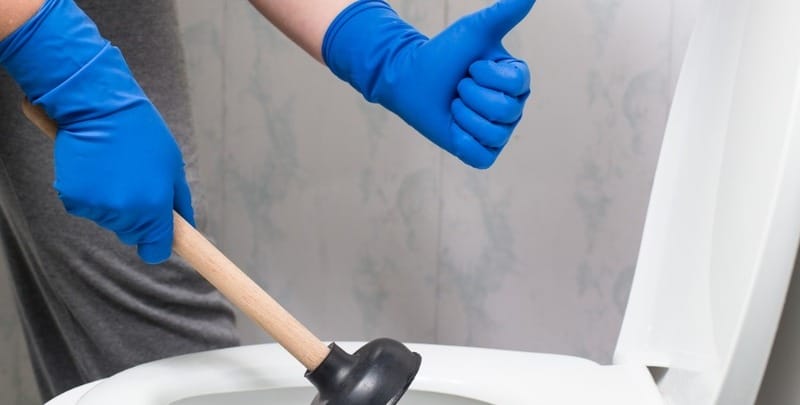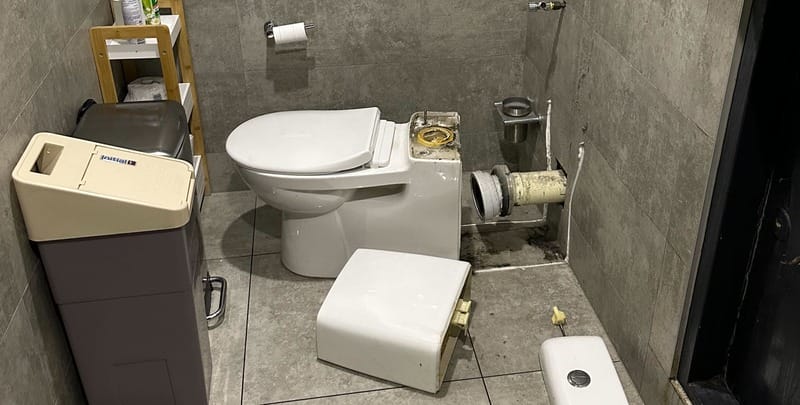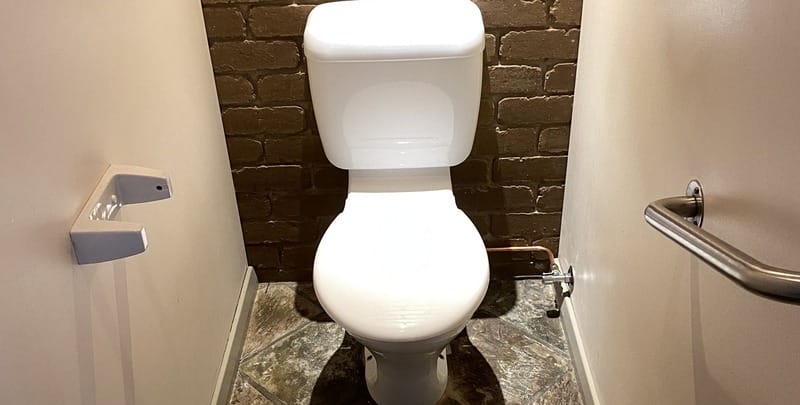Why is My Toilet Not Flushing? Here are 5 Main Reasons

Ah, the frustration of a non-flushing toilet − a scenario all too familiar to many of us. You press the handle, expecting that satisfying swirl, only to be met with silence and stagnation.
But fear not, you’re not alone in this predicament. Whether you’re facing this issue for the first time or it’s become a recurring nuisance, understanding the underlying reasons behind your toilet’s refusal to flush is crucial.
In this guide, we’re delving into the heart of the matter: the five main reasons why your toilet might not be flushing properly. From clogged drains to malfunctioning flappers, we’ll explore each potential culprit in detail. By the end, you’ll be armed with the knowledge needed to tackle the problem head-on.
So, if you’ve ever found yourself muttering, “Why is my toilet not flushing?” − worry no more. We’ve got you covered. Let’s get started and unravel the main reasons your toilet is not flushing, so you can bid farewell to the woes of a stubbornly stagnant toilet once and for all.
1. Clogged Drain
Ever experienced the frustrating moment when you flush the toilet, only to watch the water rise and then stubbornly refuse to disappear? Yep, you might be dealing with a clogged drain.
Over time, bits of toilet paper, hair and other unmentionables can build up in your pipes, creating a blockade that prevents water from flowing smoothly. The result? A toilet that simply won’t flush.
But fear not, there are ways to tackle this common issue without calling in the cavalry (aka a plumber). You can start by employing some good old-fashioned DIY solutions. Think toilet plunger, drain snakes, toilet auger or even homemade concoctions like baking soda and vinegar. These methods can often dislodge the blockage and get things flowing again in no time.
However, if your efforts prove fruitless or you suspect a more serious problem at play, it might be time to enlist the help of a professional. They’ll have the tools and expertise needed to tackle even the toughest clogs, ensuring your toilet flushes smoothly once more.
Remember, only toilet paper and human waste should be flushed down a toilet bowl. Other paper (including paper towels), dirt, oils and solid objects should never be flushed.
So, next time you find yourself facing a non-flushing toilet, don’t panic − just roll up your sleeves and get ready to unclog that drain like a pro.

2. Malfunctioning Flapper
Have you ever wondered what’s behind the scenes of your toilet’s flushing mechanism? Meet the flapper − a small but mighty component responsible for regulating the flow of water from the toilet tank into the bowl.
When you press the flush handle, the flapper lifts, allowing water to rush into the bowl and create that satisfying whirlpool effect. However, when your toilet won’t flush properly, a malfunctioning flapper could be to blame.
Signs of a malfunctioning flapper often include a toilet cistern that runs continuously or fails to flush completely. This can occur due to various reasons, such as wear and tear over time or improper alignment. Fortunately, repairing or replacing a faulty flapper is a relatively simple task that even DIY novices can tackle.
To fix the issue, start by inspecting the flapper for any signs of damage or misalignment. If it appears worn or cracked, it’s time for a replacement. You can find flappers at most hardware stores and online retailers, and they’re usually affordable and easy to install.
By addressing the issue promptly, you can restore your toilet’s flushing power and prevent water wastage. So, next time you encounter a flapper-related hiccup, don’t fret − a quick fix is just a flush away.
3. Water Supply Issues
If you press the flush handle, but instead of the usual gush of water, there’s barely a trickle. What gives? Water supply issues could be the culprit behind your non-flushing toilet.
- Insufficient water supply: If your toilet isn’t receiving enough water, it won’t have the force needed to flush effectively. This can happen due to low water pressure or a partially closed shut-off valve.
- Water valve problems: Sometimes, the issue lies with the water valve itself. A faulty valve can restrict water flow or even prevent it altogether, resulting in a non-flushing toilet.
- To troubleshoot water supply issues: 1. Check other taps in your home to see if they’re experiencing low water pressure, which could indicate a broader problem with your plumbing system. 2. Ensure that the shut-off valve behind your toilet’s tank is fully open. If it’s partially closed, turning it all the way open could restore proper water flow.
- Call in the pros: If you’ve ruled out these common culprits and your toilet still isn’t flushing properly, it may be time to call in a professional plumber. They can diagnose the issue and recommend the best course of action to get your toilet back in working order.

4. Blocked Vent Pipe
Another possible culprit is a blocked vent pipe. What exactly is a vent pipe? Let’s take a look:
- Importance of vent pipes: Vent pipes play a crucial role in your plumbing system by allowing air to enter the pipes, preventing suction and ensuring smooth drainage.
- Signs of a blocked vent pipe: If your toilet exhibits symptoms like slow drainage, gurgling noises, or foul odours emanating from drains, it could indicate a blocked vent pipe.
- Clearing a blocked vent pipe: While it may sound daunting, clearing a blocked vent pipe is a task that can often be tackled with a few simple tools. Using a plumbing snake or a high-pressure water jet, you can attempt to dislodge the obstruction and restore proper airflow.
- Preventive maintenance for vent pipes: Regular inspection and maintenance of your plumbing system can help prevent vent pipe blockages. Keep an eye out for signs of trouble and address any issues promptly to avoid more significant problems down the line.
If DIY methods fail to resolve the issue, it’s best to call in a professional plumber. They have the expertise and equipment to identify and address vent pipe blockages effectively, ensuring your toilet flushes smoothly once more
5. Faulty Flush Handle
Ever experienced the frustration of pushing down on the flush handle, only to feel it give way without any action from your toilet? You might be dealing with a faulty flush handle.
Let’s examine it closer:
- Role of the flush handle: The flush handle is the bridge between you and your toilet’s flushing mechanism. When you press it, it lifts the flapper, allowing water to flow from the toilet tank into the bowl and initiate the flushing process.
- Signs of a faulty flush handle: If your flush handle feels loose, sticks, or fails to spring back into place after flushing, it could indicate a problem. Additionally, if you hear the sound of flushing but don’t see any water movement, it might mean the handle isn’t properly connected to the flapper.
- Repairing or replacing the flush handle: Fortunately, fixing a faulty flush handle is often a straightforward task. Start by inspecting the handle and its connection to the flapper. If it’s loose or damaged, tightening screws or replacing the handle altogether should do the trick.
By addressing the issue promptly, you can restore your toilet’s flushing function and avoid potential water wastage. If DIY repairs don’t solve the problem, consider seeking assistance from a professional plumber to ensure your toilet operates smoothly.

Tackling Toilet Troubles
So, there you have it − the five main reasons why your toilet might not be flushing properly. From clogged drains to faulty flush handles, we’ve covered the common culprits behind this frustrating issue. Armed with this knowledge, you’re well-equipped to tackle any toilet troubles that come your way.
Remember, regular maintenance and prompt attention to issues are key to keeping your toilet in tip-top shape. Whether it’s clearing a clogged drain, replacing a malfunctioning flapper, or addressing water supply issues, a little effort now can save you from bigger headaches down the line.
Remember that prevention is always better than cure. Only toilet paper or human waste should be flushed into sewer pipes. Even too much toilet paper can be a culprit when your toilet won’t flush.
And if all else fails, don’t hesitate to contact a qualified plumber. Plumbers have the expertise and tools needed to diagnose and resolve even the trickiest broken toilet, ensuring your bathroom stays in working order.
So, the next time you find yourself asking, “Why is my toilet not flushing?” don’t despair. With a bit of know-how and a can-do attitude, you’ll have that toilet flushing like new in no time. Here’s to smooth-sailing bathroom experiences and a happy, fully functional toilet.
Please note: This information is provided for advice purposes only. Regulations differ from state to state, so please consult your local authorities or an industry professional before proceeding with any work. See our Terms & Conditions here.